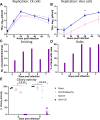The spike protein of the apathogenic Beaudette strain of avian coronavirus can elicit a protective immune response against a virulent M41 challenge
- PMID: 38265985
- PMCID: PMC10807761
- DOI: 10.1371/journal.pone.0297516
The spike protein of the apathogenic Beaudette strain of avian coronavirus can elicit a protective immune response against a virulent M41 challenge
Abstract
The avian Gammacoronavirus infectious bronchitis virus (IBV) causes major economic losses in the poultry industry as the aetiological agent of infectious bronchitis, a highly contagious respiratory disease in chickens. IBV causes major economic losses to poultry industries across the globe and is a concern for global food security. IBV vaccines are currently produced by serial passage, typically 80 to 100 times in chicken embryonated eggs (CEE) to achieve attenuation by unknown molecular mechanisms. Vaccines produced in this manner present a risk of reversion as often few consensus level changes are acquired. The process of serial passage is cumbersome, time consuming, solely dependent on the supply of CEE and does not allow for rapid vaccine development in response to newly emerging IBV strains. Both alternative rational attenuation and cell culture-based propagation methods would therefore be highly beneficial. The majority of IBV strains are however unable to be propagated in cell culture proving a significant barrier to the development of cell-based vaccines. In this study we demonstrate the incorporation of a heterologous Spike (S) gene derived from the apathogenic Beaudette strain of IBV into a pathogenic M41 genomic backbone generated a recombinant IBV denoted M41K-Beau(S) that exhibits Beaudette's unique ability to replicate in Vero cells, a cell line licenced for vaccine production. The rIBV M41K-Beau(S) additionally exhibited an attenuated in vivo phenotype which was not the consequence of the presence of a large heterologous gene demonstrating that the Beaudette S not only offers a method for virus propagation in cell culture but also a mechanism for rational attenuation. Although historical research suggested that Beaudette, and by extension the Beaudette S protein was poorly immunogenic, vaccination of chickens with M41K-Beau(S) induced a complete cross protective immune response in terms of clinical disease and tracheal ciliary activity against challenge with a virulent IBV, M41-CK, belonging to the same serogroup as Beaudette. This implies that the amino acid sequence differences between the Beaudette and M41 S proteins have not distorted important protective epitopes. The Beaudette S protein therefore offers a significant avenue for vaccine development, with the advantage of a propagation platform less reliant on CEE.
Copyright: © 2024 Keep et al. This is an open access article distributed under the terms of the Creative Commons Attribution License, which permits unrestricted use, distribution, and reproduction in any medium, provided the original author and source are credited.
Conflict of interest statement
I have read the journal’s policy and the authors of this manuscript have the following competing interests: A patent has previously been filed by The Pirbright Institute to protect the intellectual property of the work surrounding mutations Pro85Leu in Nsp 10 and Val393Leu in Nsp 14 (Patent name: Coronavirus, Number EP3172319B1, Authors: Erica Bickerton, Sarah Keep and Paul Britton). The authors declare no additional conflicts of interest. This does not alter our adherence to PLOS ONE policies on sharing data and materials.
Figures






References
-
- Najimudeen SM, Abd-Elsalam RM, Ranaweera HA, Isham IM, Hassan MSH, Farooq M, et al.. Replication of infectious bronchitis virus (IBV) Delmarva (DMV)/1639 variant in primary and secondary lymphoid organs leads to immunosuppression in chickens. Virology. 2023;587:109852. doi: 10.1016/j.virol.2023.109852 - DOI - PubMed
MeSH terms
Substances
LinkOut - more resources
Full Text Sources
Medical
Research Materials

